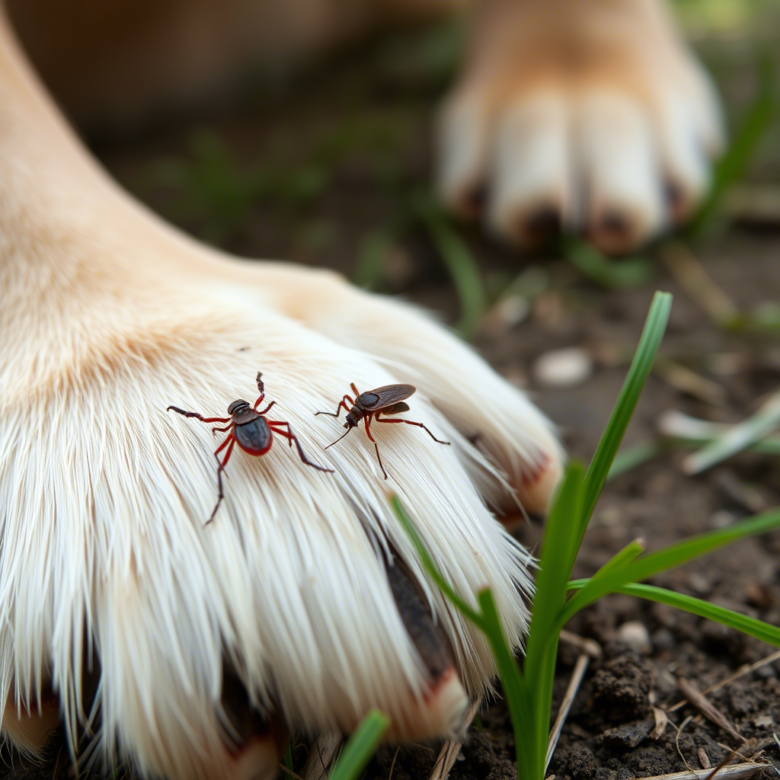Introduction to Ticks and Mosquitoes
Ticks and mosquitoes are two prevalent pests that pose significant health risks to both humans and animals, particularly pets. These ectoparasites thrive in various environments, making them a common concern for pet owners. Ticks are often found in wooded areas, tall grasses, and shrubs, where they attach themselves to hosts as they pass by. Mosquitoes, on the other hand, are more likely to be found in areas with stagnant water, such as ponds, rivers, and even puddles. Their life cycles typically involve both aquatic and terrestrial stages, making them extremely adaptable to different environments.
The increasing prevalence of ticks and mosquitoes in suburban areas can be attributed to various factors, including climate change, urbanization, and changes in wildlife populations. As temperatures rise, these pests extend their active seasons, resulting in a greater risk of exposure for pets. Pet owners should be particularly vigilant during warmer months when the likelihood of encountering ticks and mosquitoes significantly increases. Moreover, certain breeds of pets may be more susceptible to the diseases transmitted by these parasites, making awareness and preventative measures crucial.
Ticks are vectors for multiple pathogens that can lead to serious health issues in pets, such as Lyme disease and ehrlichiosis. Similarly, mosquitoes are known carriers of heartworm disease, which can cause severe cardiovascular damage. Understanding the habitats and behaviors of these pests is fundamental for minimizing exposure risks. By taking proactive measures, pet owners can better safeguard their furry companions from the hidden dangers posed by ticks and mosquitoes, thereby promoting their long-term health and well-being.
The Health Risks Associated with Ticks
Ticks are more than just annoying pests; they pose significant health risks to pets, primarily as carriers of various diseases. One of the most well-known is Lyme disease, which is transmitted through the bite of infected ticks, particularly the black-legged tick. Lyme disease can cause a range of symptoms in pets, including fever, loss of appetite, lethargy, and stiffness or lameness. If left untreated, this condition can lead to severe joint problems and long-term health complications, affecting your pet’s overall well-being.
Another critical illness transmitted by ticks is Anaplasmosis, which, like Lyme disease, is spread by deer ticks. This bacterial infection can lead to symptoms such as fever, lethargy, and joint pain, usually appearing a week or two after exposure. In pets, the disease can result in significant health issues, including low platelet counts, which may cause abnormal bleeding. If diagnosed early, Anaplasmosis is treatable with appropriate antibiotics; however, delays in treatment can have lasting effects on a pet’s health.
Moreover, other tick-borne diseases, such as Ehrlichiosis and Babesiosis, can also affect pets. Ehrlichiosis may cause symptoms such as weight loss, fever, and bleeding disorders, while Babesiosis often leads to anemia and jaundice. Each of these conditions can severely impact your pet’s quality of life if not detected and managed promptly. Regularly checking for ticks after outdoor activities and maintaining preventive treatments is crucial for protecting your pets against these hidden health threats. Being vigilant about symptoms and seeking veterinary care at the first sign of illness can help minimize the risks associated with tick-borne diseases.
The Health Risks Associated with Mosquitoes
Mosquitoes are not merely a nuisance during the warmer months; they pose significant health risks to pets, particularly through the transmission of infectious diseases. One of the most concerning diseases transmitted by mosquitoes is Heartworm disease, a serious condition caused by a parasitic worm known as Dirofilaria immitis. This parasite primarily affects dogs, although it can also infect cats and other species. The transmission occurs when an infected mosquito bites a pet, thereby transferring the larvae into the bloodstream.
Once inside the host, the Heartworm larvae mature and migrate to the pulmonary arteries, where they can grow up to twelve inches long. This can lead to severe damage to the heart and lungs and can impede normal circulation. Symptoms of Heartworm disease may not appear immediately; however, as the infection progresses, pet owners may notice coughing, fatigue, decreased appetite, and weight loss in their pets. In advanced cases, the disease can lead to heart failure and ultimately death if left untreated.
Diagnosis of Heartworm disease typically involves blood tests conducted by a veterinarian, which can detect the presence of heartworm proteins. If diagnosed, treatment options are available but may carry risks, including potential complications from the medications used. The most common treatment involves administering injections of a drug that kills adult heartworms, often requiring hospitalization and close monitoring of the pet’s recovery.
Prevention is crucial in protecting pets from Heartworm disease. Veterinarians recommend regular testing and providing pets with monthly preventative medications that can significantly reduce the risk of infection. Ensuring a pet is on a preventive treatment regimen not only safeguards their health but also contributes to the overall control of the heartworm population in the area. Understanding the risks associated with mosquitoes and Heartworm disease is vital for all pet owners, as early intervention and preventive measures can greatly enhance the well-being of beloved pets.
How Ticks and Mosquitoes Affect Pets Differently
Ticks and mosquitoes are two common parasitic threats that impact the health of pets, yet they manifest their dangers in distinct ways. Ticks are ectoparasites that attach to the skin of animals, feeding on their blood and often transmitting lethal diseases through complex life cycles. The most notable tick-borne illnesses affecting pets include Lyme disease, Ehrlichiosis, and Rocky Mountain spotted fever. The lifecycle of a tick begins as an egg, metamorphosing into larvae, nymphs, and finally into adults. This prolonged lifecycle allows them ample opportunity to latch onto host animals at various stages, increasing the risk of disease transmission. The slow and incremental feeding process means that pet owners may not immediately notice a tick on their animal until signs of illness, such as lethargy or fever, begin to appear.
In contrast, mosquitoes pose a more immediate threat, primarily through the transmission of diseases such as heartworm disease. Mosquitoes inject larvae into the bloodstream when feeding, resulting in rapid infection. Heartworms can grow to significant lengths within the heart and pulmonary arteries of pets, leading to severe heart and lung problems. Unlike ticks, which require direct contact with the host to transmit disease, mosquitoes can infect multiple pets in a short time span, making them a more pervasive danger in specific geographic areas. The lifecycle of a mosquito is significantly shorter, and their ability to breed in standing water allows their populations to surge, especially in warm and humid conditions.
Due to these differences, preventative measures must vary. While tick preventatives often involve topical treatments or collars that repel and kill ticks, mosquito prevention may focus more on environmental control, such as reducing standing water and using repellents. Understanding the unique risks associated with each parasite is essential in ensuring the health and safety of pets.
Signs and Symptoms of Tick and Mosquito-Borne Illnesses
Recognizing the signs and symptoms of tick and mosquito-borne illnesses in pets is crucial for timely veterinary intervention. These vectors are known to transmit various diseases that can significantly affect the health and well-being of animals. One of the primary symptoms pet owners should observe is changes in a pet’s energy levels. Lethargy or an unusual reluctance to engage in regular activities often indicates that something is amiss. This sudden decrease in energy can be a symptom of conditions such as Lyme disease or West Nile virus, and it warrants prompt attention.
Behavioral changes can also serve as important indicators. A pet who is typically friendly may become withdrawn or irritable. In addition, certain physical symptoms, such as excessive scratching, biting at specific areas of the body, or the presence of swelling, should raise red flags. This could suggest a possible tick infestation or an allergic reaction, necessitating an examination for tick-borne pathogens. Conversely, if a pet exhibits signs of high fever, vomiting, or diarrhea, these may signal more serious infections, including heartworm disease, which is transmitted by mosquitoes.
Furthermore, if a pet begins to show signs of lameness or joint pain, it could be associated with diseases like Lyme disease, which affects the joints and can lead to chronic issues if not addressed appropriately. Keeping an eye on your pet’s appetite is equally important; a sudden change, either an increase or a decrease in food intake, can indicate underlying health problems that may be connected to vector-related illnesses.
Overall, pet owners should maintain awareness of these signs and symptoms, as early detection can lead to more effective treatment and improve the quality of life for affected animals. Regular check-ups with a veterinarian and preventive measures will also play a vital role in safeguarding pets against tick and mosquito-borne diseases.
Preventative Measures: Protecting Your Pets
Protecting your pets from ticks and mosquitoes is a critical aspect of responsible pet ownership. Implementing best practices can significantly minimize the risks associated with these pests and help ensure the health of your furry companions. One of the most effective methods of prevention is through the use of veterinarian-recommended preventive medications. Numerous products are available, including topical treatments, oral medications, and collars designed to repel and kill ticks and mosquitoes. Regular discussions with your veterinarian can help you select the most suitable option based on your pet’s specific needs and lifestyle.
In addition to medication, regular veterinary check-ups, ideally every six months, are essential. These visits allow for early detection of any potential issues related to tick or mosquito exposure, as well as appropriate vaccinations that can further safeguard your pets against vector-borne diseases. Your veterinarian can also provide essential guidance on how to monitor your pets for any signs of illness or discomfort.
Grooming is another vital component of preventing tick and mosquito infestations. Regular brushing and bathing can help keep your pet’s coat healthy and free from pests. It is advisable to perform thorough inspections of your pet’s fur, especially after outdoor activities in areas known to harbor ticks. Early removal of ticks, before they attach, can drastically reduce the risk of transmission of specific diseases.
Furthermore, creating a safer home and yard environment is crucial. Keeping your yard well-maintained by regularly mowing the lawn, trimming shrubbery, and removing any standing water can significantly reduce mosquito populations. Consider employing natural deterrents, such as planting mosquito-repellent plants or using organic solutions that are pet-safe. Indoor strategies could include using screens on windows and doors to prevent mosquitoes from entering, along with regular cleaning to keep surfaces clear of pests. By following these preventive measures, pet owners can provide a safer and healthier environment for their beloved animals.
Seasonal Patterns of Tick and Mosquito Activity
Understanding the seasonal behavior of ticks and mosquitoes is crucial for pet owners aiming to protect their furry companions from these potential health threats. Generally, tick and mosquito activity correlates with temperature and humidity levels, which influence their breeding and feeding patterns. In many regions, ticks tend to be most active during the warmer months, specifically from spring through early fall. This period, often marked by increased outdoor activities, draws pets and their owners into environments where ticks are prevalent, such as wooded areas and grassy fields.
Specifically, the peak of tick season typically occurs from March to June when temperatures rise and humidity levels are favorable for tick maturation. These parasites thrive in areas with high moisture, making early spring a significant time for vigilance. Furthermore, the life cycle of ticks varies by species, but many peak in abundance during these spring and summer months, highlighting the importance of preventative measures such as regular tick checks and appropriate treatments.
Conversely, mosquito populations also flourish during the warmer months, with peak activity from late spring through the summer. Mosquitoes are especially prevalent in areas with standing water, making it imperative for pet owners to eliminate breeding sites by removing stagnant water around their properties. While adult mosquitoes typically begin to emerge with the warmth of spring, populations can explode by mid-summer, necessitating heightened awareness for pet owners during this time. Many mosquitoes can transmit harmful diseases to pets, including heartworm and West Nile virus, emphasizing the need for preventive measures, such as repellent treatments and mosquito nets.
Thus, understanding these seasonal trends can help pet owners be more prepared and proactive, ensuring that their pets remain safe and healthy during times of heightened tick and mosquito activity.
Veterinary Recommendations and Treatments
When pet owners bring their animals to the veterinarian for concerns related to ticks and mosquitoes, they can expect a comprehensive approach to diagnosis and treatment. Initially, the veterinarian will conduct a thorough physical examination to assess any immediate health issues caused by these parasites. This may include observing for signs of infection, such as swelling, redness, or any unusual behavior that might indicate discomfort or distress in the pet.
Diagnostic procedures often include blood tests to identify diseases transmitted by ticks, such as Lyme disease or ehrlichiosis. These tests are crucial in determining the appropriate course of action, as symptoms can vary significantly depending on the parasite involved and the severity of the infection. In addition to blood work, veterinarians may recommend additional diagnostic imaging if there are complications or advanced symptoms present.
Treatment protocols for tick and mosquito-related illnesses often involve a combination of medications and supportive care. For mild infections, a veterinarian may prescribe antibiotics or antifilarial medications to combat the specific parasites affecting the pet. Pain relief and anti-inflammatory medications may also be administered to enhance the animal’s comfort during recovery. In severe cases, particularly those involving heartworm disease transmitted by mosquitoes, more intensive treatments, including hospitalization or intravenous therapies, may become necessary.
Prevention is a key focus during veterinary consultations. Veterinarians will discuss various preventive measures, such as topical treatments, oral medications, and vaccines that can help mitigate the risk of future infestations. Regular tick checks and maintaining a tick-free environment are also valuable topics for discussion. Engaging in open dialogue with veterinarians about preventive options empowers pet owners to make informed decisions regarding their pets’ health and well-being, ultimately reducing the risks associated with tick and mosquito exposure.
Conclusion
In examining the hidden dangers posed by ticks and mosquitoes, it becomes clear that vigilance and care are imperative for pet owners. These pests not only threaten the health of our beloved animals but can also pose risks to human household members. The importance of being proactive in protecting our pets from these threats cannot be overstated. Regular inspections of your pets for ticks, especially after outdoor activities, and maintaining a mosquito-free environment at home can significantly reduce risks associated with these pests.
Implementing preventive measures such as vaccinations, tick and flea treatments, and using repellents specifically designed for pets can greatly enhance their safety. Additionally, maintaining a tidy yard and removing standing water can help mitigate mosquito populations, thereby creating a safer environment for both pets and family members. Awareness of the symptoms of tick-borne diseases or mosquito-related illnesses is crucial for prompt treatment should they occur. By recognizing early signs of trouble, pet owners can act swiftly to safeguard their animal’s health.
Ultimately, consistent vigilance can lead to a more enjoyable and healthy lifestyle for pets. It is essential for pet owners to remain informed on the risks associated with these pests, engage in preventive care, and seek veterinary advice when necessary. Our pets rely on us to provide a safe habitat, free from the dangers that ticks and mosquitoes present. By being attentive and proactive, we can ensure our pets lead long, happy, and healthy lives, free from the consequences of these hidden dangers.


